ARTIFICIAL INTELLIGENCE
Steve Grindle delves into the wonderful world of lures — a world he suggests has never been bigger or better.
I don’t know about you, but over the years I haven’t found too many people who wouldn’t rather catch a predatory fish on bait over a well presented artificial. Often visual, there will always be something special about fooling a fish on a well-presented lure or fly that you simply don’t get from bait fishing. Generally, you can travel much lighter too, with no need to carry rod rests, berley, heavy eskies, jetty trolleys and the like.
Covering more ground and ending the day with a lot less cleaning up to do is a bonus, especially so if you’re haphazard with baiting up techniques and don’t carry a cloth to keep your hands clean. Rod grips and reel seats can get messy quickly, especially when boat fishing for gar and slimies —species that love to shed scales everywhere. Beach salmon fishing also comes to mind. Between sand, bleeding fish, fish slime and baiting up with pillies, rod grips and reel seats inevitably end up looking like a scene from a Hannibal Lecter movie in a very short space of time. With no cleaning cloth in sight, the quickest resort ends up being the back of your pants, which then gets transferred to the car seats. Don’t laugh, as we’ve all been guilty of it at some stage.
To sum up, the benefits of fooling fish on artificials often outweigh using bait in many situations, so let’s take a look at some of the specialised gear and tactics available to us.
FLY FISHING
Flyfishing in this country, especially in salt water, has come a very long way since its humble beginnings of basicallytied deceivers made of chicken feathers and heavy rods and reels designed to cast your arm off and fight fish. Admittedly, fly fishing will never be everybody’s cup of tea, but for those wanting a bigger challenge on species they may have fished for with traditional bait and lure techniques, it can become highly addictive. Fly fishing can also offer certain advantages over lure fishing. In both fresh and salt water even a big fly will touch down with a lot less noise and fuss than a lure, which is especially important when fish can be visually targeted and close casts are necessary. Think fishing both man-made and natural structures for spooky bream or targeting them visually on the flats.
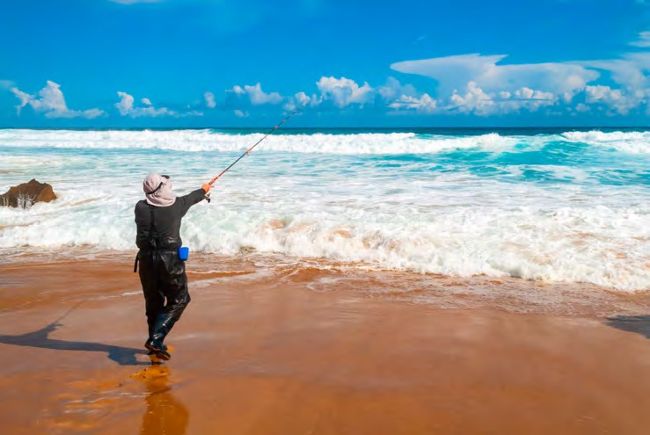
Metals still work best in the surf
Big carp are another species that quickly spring to mind in clear, shallow backwaters where visually stalking them is popular. Big bonefish, the ultimate light tackle target on the flats, are often found tailing in a foot or less of water. Light touch downs with the smallest of flies cast slightly ahead of the fish are the name of the game here, to avoid spooking a species that seems to be on high alert most of the time.
Modern, well equipped fly tiers can tie a fly to pretty much represent anything these days, from small baitfish patterns for casting at pelagic schools, to bread flies for carp and mullet or shrimps crabs and larger rattling flies, suitable for barra and big Murray cod. There are even flies shaped with contractors’ silicone, designed by notable tier Geoff Skinner, to imitate half or full pilchards, for drifting down berley trails for species such as spooky yellowfin tuna, snapper and sharks. That’s if you can call it flyfishing.
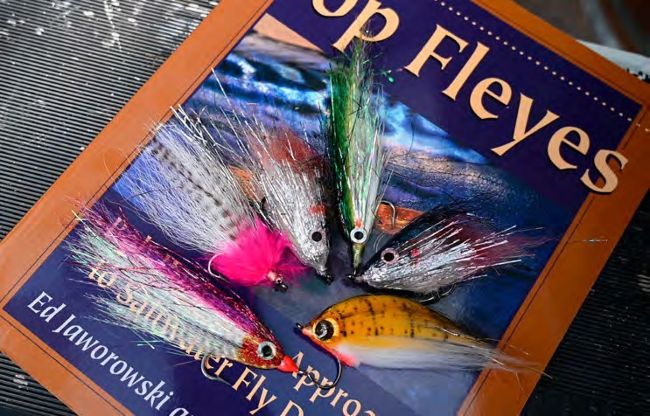
Flies are sometimes the most effective option
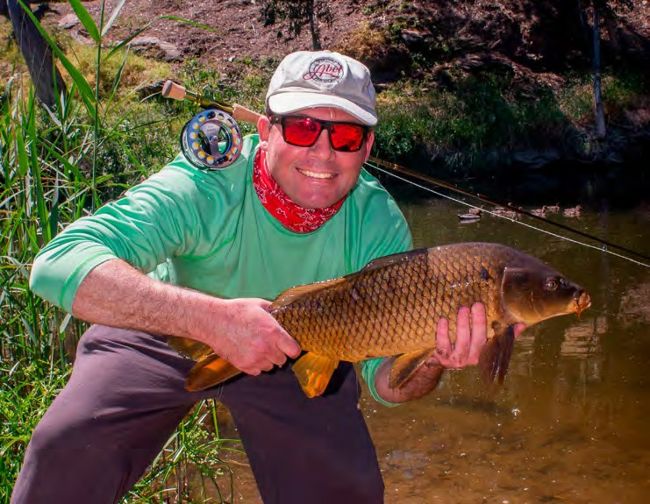
The author with a chunky fly-caught carp
Here in SA the humble clouser minnow tied in various sizes, weights and colours will catch just about any species, from black bream, to kingfish and Australian salmon. A white, sparsely-tied version with a little bit of flash and lead dumbell eyes, is close to perfect for those wanting a challenge on our increasing numbers of inshore southern bluefin tuna, if you can find a busting school on the surface.
Last of all, if finding a specialised fly online for a certain species proves difficult, why not learn to tie up a few of your own wild creations? It’s amazing what’s possible with some five-minute Araldite and a few coloured Sharpie markers. For light estuary flies suited to bream and the like, Mustad’s light gauge chemically sharpened Aberdeen patterns are the go. For larger, stronger predatory fish, the Gamakatsu SL12s is pretty much standard fair these days for a super strong, razor sharp, stainless hook to base flies on.
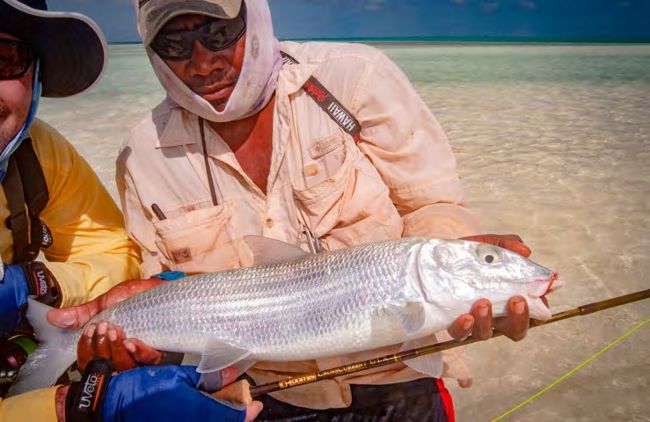
Bonefish are the ultimate fly/lure target
SURFACE STRIKES
Catching fish off the surface on artificials is arguably the most fun any angler can hope to have. Whether it’s big queenfish and trevally interstate or overseas, or on our very own yellowfin whiting, Australian salmon or impoundment Murray cod here in SA, it’s always extremely exciting to see a predatory fish nail a well presented artificial off the top, with strikes often explosively spectacular.
There are so many lures on the market these days, it’s hard for newcomers to know where to even start. As with many facets of fishing, there are a few standout, go-to lures that should be in every angler’s arsenal. Aussiemanufactured Ballista lures are the cream of the crop when it comes to oversized artificials for cod, with the 200mm Tremor and 90mm Hunchback extremely popular. They come in a cracking range of colours and push out a lot of commotion on the surface, sending sound waves down through the water column that cod can’t seem to resist. Best of all, if you create an account and order through the website, they have member-only specials where lures are often marked down to half price and a few nice stickers and stubby holders are thrown into boot. Who doesn’t enjoy supporting Australian small business lure manufacturers and receiving a big parcel of fresh new lures in the post!
Chasebaits is another wellknown manufacturer that makes all sorts of highly innovative offerings for both fresh and salt water. Their Cicada, which is highly popular with Australian bass anglers, comes in at a mere 43mm long, has a unique walking action, and is ideal for fishing off lighter tackle for smaller cod. Fished around structure at dawn or dusk, I wouldn’t be at all surprised if somebody nails a big bream or school mulloway on one of these superb lures, especially in the more pristine waters of Kangaroo Island or at the top of both gulfs. For bream the hooks out of the box are fine, but I’d be upping the ante to stronger and slightly larger hooks for impoundment fishing on natives.
In the salt for ultra-light tackle fishing the flats for flathead, salmon and summer yellowfin whiting, two lures stand alone: the Bassday Sugapen and OSP Bent Minnow. Both lures have extremely unique actions, come in various sizes and extremely natural colours sprayed over clear, transparent bodies that are very well suited to flats fishing scenarios. The price of Bent Minnows though can be summed up in one word: astronomical. Fishing with sensible tackle and slightly heavier fluoro carbon leader material, especially in locations where big flathead that will scuff through light leader in no time reside, will certainly help ease the pain of losing one to a deeply hooked fish.
On larger species such as salmon, Halco’s Roosta Popper in the small and medium sizes is a great choice, and even casts well enough to reach sufficient distance to target fish from the beach, especially if the wind is blowing offshore.

Our reservoir cod love artificals
DOWN DEEP
Vibes and blades are, arguably, the most versatile lures on the market, and a must-have in the box. Both cast extremely well, put out a lot of vibration when worked correctly and, due to their weight and design, can be cast a long way and fished anywhere from just below the surface to any depth; reel capacity is the only limiting factor.
Metal vibes have really been kicking goals on our impoundment redfin, especially when used in conjunction with sounders to locate a school first. Due to their size, they are also very popular with bream anglers in the smallest sizes, while larger models might be the key to staying connected to jumping salmon due to most sporting twin treble hooks. Jackall vibration baits are quite simply impoundment Australian bass and native magnets.
ON THE FLATS
Hitting the water, getting your backside wet and being close to nature is one of the most highly effective ways of catching fish, and the next step up from being a jetty rat or casual, bankside river angler. Wading the flats sharpens fish finding skills, teaches you how to read the water and bottom structure, and the importance of fishing tides in these areas.

Blades have developed a huge following
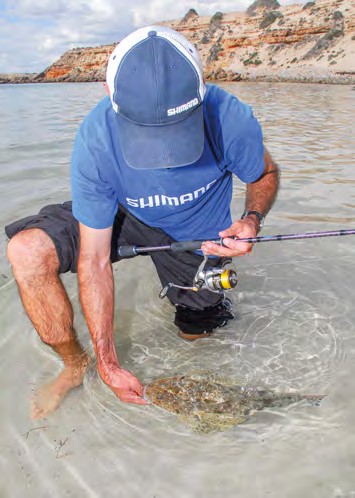
Flatties are prime lure targets
Lastly, don’t forget to make that little bit of extra room for a squid jig or two. You’ll be surprised how many squid can be found, especially when throwing 10cm or larger minnow lures over patches of reef and sea grass.
Flat plateaus of reef that drop vertically into much deeper water covered in sand are classic flathead ambush spots, where a dropping tide funnels food off the flats into prime ambush territory. Working diving, suspending lures like the Daiwa Double Clutch off the flats into the deeper channels, or cranking a weighted soft plastic off the shallows and allowing it to drop vertically over the drop-off, are proven tactics for targeting big flatties in these locations. Be prepared to hang on and fish a reasonable drag setting though, as big flathead are just as adept at finding holes and sharp edges to cut through braided lines as salmon are for throwing hooks.
Keeping the rod low and attempting to steer fish quickly away from cover without getting cut off is a skill that will be hard earned in these locations. The lure box can start looking very sad and sorry for itself if one isn’t on the ball when the fishing is hot.
GEAR CHOICES
As with many anglers, my rods and reels of choice for light tackle lure casting are forever evolving. Offthe-rack Ian Miller Production rods make up the majority of my light tackle baitcasting and spinning rods these days, along with a smattering of off the rack Shimano Anarchys. I’m no brand snob though, with a mix of both Daiwa and Shimano reels, namely Luvias and Stradic HG’s, tightly secured to the reel seats, along with a few lesser-known brands over the last twelve months or so.
One company that’s getting a lot of attention recently is the American-based Favourite USA Rod and Reel Company, which is producing some competitively priced and extremely wildly coloured light tackle baitcasting reels for the Yankie bass market. Well suited to Australian conditions, many of their offerings come in at price points roughly half of what you’d expect to pay from the big two.
It’s early days yet with the LT 100 model I’ve been fishing for the last year, but things are looking very promising so far. I’m fully expecting only easy component swaps to be needed once the wear and tear of continuous casting for natives sets in, such as upgrading the drag to Carbontex washers and maybe switching out the bearings for higher quality ceramic versions, easily available and sourced off eBay for many different reels.
Not to be outdone, alongside the favourite I’m also fishing a Shimano 18 Bantam on the heavy cod rod, so it will be interesting to compare the smoothness of each few years down the track, to see how the internals and general feel of each reel is faring. While nowhere near cheap, the Bantams are far from the most expensive low profile baitcasters on the market; they just feel right straight from the box and fit in the hand like a glove. They really are a well thought out and manufactured product.
Get out over summer while the weather’s good. You just never know what will turn up throwing lures and flies around our wonderful state.
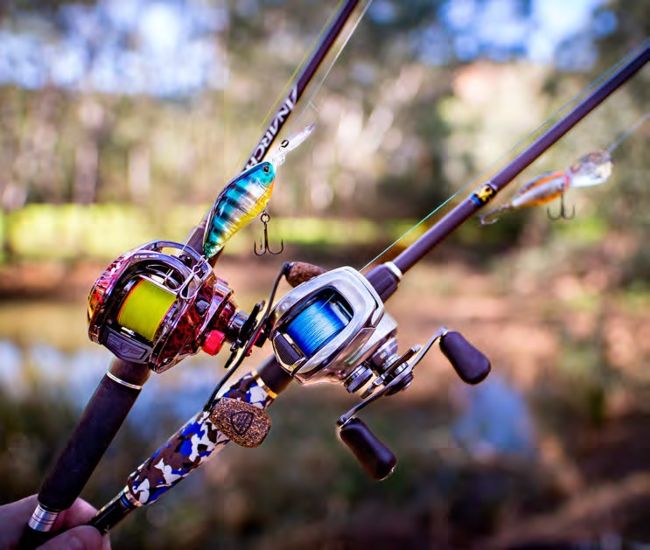
Deep divers work well, either trolled or cast